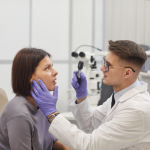Eating the right food in the right quantity is an essential part to have a healthy lifestyle. Diet also affects the long-term effects on ocular health. There are vitamins and minerals found in food helps in preventing two common causes of vision problems: cataracts which create cloudy areas in the lens of the eye and age-related macular degeneration (AMD), a condition that causes vision loss in the macula, the part of the eye that controls central vision. According to the World Health Organisation, 9 per cent of the overall population is 65 or older than that and this number is expected to increase to 17 per cent by 2050. As the name suggests, Age-related macular degeneration (AMD), the risk of this condition is higher in the old age group as compared to others.
It is necessary to consume the proper amount of nutrients in your daily diet. According to the National Cancer Institute and U.S. Department of Agriculture, it is necessary to have five servings of fruits and vegetables per day. This certain diet should include more than 100 mg of Vitamin C, 5mg to 6mg of carotenoids which should have sufficient elements of lutein and zeaxanthin. It is equally important to consume Vitamin E, so to get 8-14 mg of Vitamin E one should eat two servings of nuts and seeds. This is what expected to keep your eyes healthy for the long run. See the tables below for good food sources of these nutrients. Compared to given diet the average daily diet that we generally consume contains approximately 100 mg of vitamin C, 1 to 7 mg lutein and zeaxanthin, and 8 mg vitamin E which is certainly not potential enough for our eyes. In the studies mentioned here, the consumption levels associated with cataract benefits were considerably higher than the current average intake. Sometimes it is difficult to increase the level of these antioxidants and carotenoids in your diet, so at such times one can start taking multivitamin/mineral and eye health supplements containing these nutrients.
Here is proper recommended diet that one should follow:
There is certain food which helps in making your vision strong. Food which contains omega-3 fatty acids, lutein and zeaxanthin helps your eyes from attracting unwanted diseases.
Omega-3 Fatty acids
DHA substance in Omega-3 fatty acid is considered to be tout for many health benefits including health if eyes. DHA is also considered to be the most difficult substance to consume through a normal diet but if included in the regular diet it helps tremendously for vision protection. It occupies almost 30% of brain matter and prevents age-related vision loss. Omega-3 fatty acids are actually polyunsaturated fatty acids. It is also written as n-3 or w-3. These acids include alpha-linolenic acid, EPA, and DHA. Alpha-linolenic acid is a precursor of EPA and DHA.
Dr Bajart explains her research, “DHA is the primary structural fatty acid of the grey matter of the brain and the retina”. Therefore, it is conveniently proved that DHA supplements or a rich diet including DHA help in degeneration of the retina. Even though DHA will not reverse the retinal damage, it may certainly help to preserve vision, relive dry eyes and chronic inflammation of the eyelids.
DHA is majorly found in the food substances like salmon, cod, tuna and more. There are many cold-water fish which are rich in Omega-3 fatty acids such as salmon, tuna, sardines and mackerel. To get a good supply of omega-3s to have fish oil supplements or eat vegetarian supplements that are rich in black currant seed oil or flaxseed oil. Fish Oil, Flaxseed Oil and Black Currant Seed Oil contains omega-3 fatty acids and have many eye health benefits, including helping to prevent or control dry eye syndrome as well as reduce the risk of macular degeneration and cataracts. Pistachios, walnuts, almonds fancy are also highly rich in omega-3 fatty acids and vitamin E that will certainly boost your eye health.
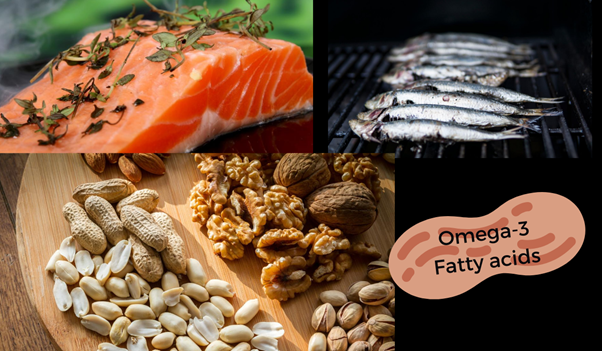
The Faculty of Medical and Human Sciences at the University of Manchester showed that, "patients who achieved high red blood cell membrane EPA/DHA levels were significantly protected against AMD compared with those with permanently low EPA/DHA levels.” This helps or helps to reduce Macular degeneration which is commonly found in the old age people. Omega-3 fatty acids have also proved helpful for glaucoma patients.
How much one should consume Omega-3 fatty acids?
According to the researcher, the test has been conducted that measured the amount of EPA and DHA in the blood. So according to the study, one should have desirably 8% -12% of Omega-3 fatty acids in their body. Anything between 4%-8% is considered to be intermediate whereas <4% is totally undesirable and may cause serious issues in future with respect to vision.
Greens and coloured food
Green veggies and colourful fruits contain carotenoid lutein and zeaxanthin. Lutein and Zeaxanthin help reduce discomfort vision, risk of age-related macular degeneration (AMD) and many other eye-related problems. Carotenoid is only found in natural plants and helps to protect call damage. Lutein also is found stored in the macula of the human eye. It is an antioxidant found in carotenoid-rich foods. Lutein is found in the critical point of the retina that receives and absorbs light. Boost these healthy rainbows coloured lutein-rich food in your diet and help yourself and your family to reduce the risk of any eye-related problems.
Leafy greens like spinach, kale and collard greens, to name just a few, are packed full of lutein and zeaxanthin. It is one of the important plant pigments that can help stem the development of macular degeneration and cataracts. Broccoli, peas and avocados are also good sources of this powerful antioxidant duo. Also, colourful foods like oranges, grapefruits, lemons and berries are high in vitamin C, which may reduce the risk of cataracts and macular degeneration. To protect your eyes from night blindness and dry eyes and to promote eye health and function soundly one should increase the consumption of eggs. Eggs include Lutein and Vitamin A that will help your eyes stay healthy and disease-free for a long time. Similarly, one can snack on sunflower seeds too. These seeds are highly potential to provide your eyes Vitamin E and zinc.
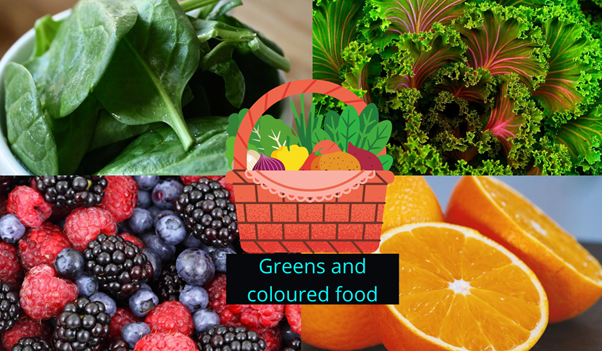
Researchers from the National Eye Institute (NEI) suggested that including these foods in your diet will certainly prevent AMD risk. Another interesting benefit of eating lutein-rich food will decrease the risk of cataract formation in your eye. Not only these but these foods will help cancer prevention and improve heart health.
How much one should consume Greens and colourful food?
According to the Westmead Institute for Medical Researchers, beetroot has nearly 15 mg while spinach has about 20 mg and nitrate per 100 grams. The study has also proven the intake of these foods are more than 142 mg of dietary nitrate each day will not help resolve the eye-related problems. Hence, it is necessary one should know what and how much they are eating. Follow this particular table below for the right amount of food that you should consume in your diet.
Good food sources of Lutein and Zeaxanthin (mg/serving)
*depending on variety and preparation
Good food sources of Vitamin C (mg/serving)
Wink with Zinc
Zinc has proven to the trace element that helps cell metabolism. It helps in functioning ocular normally. Zinc is present in high amount in retina and choroid. If someone has zinc deficiency they might see the symptoms in vision especially at night. Zinc helps to create melanin which protects your eye through Vitamin A.
Food like lean beef in your diet can boost your eye health. To reduce the risk of advanced age-related macular degeneration, it is necessary to consume beef. Beef contains a good amount of zinc in it, which helps absorbing vitamins and lead to reduce the risk of AMD. Similarly, to protect your retina and to decrease the risk of macular degeneration and cataracts, try eating foods like kidney beans, black-eyed peas and lentils. These foods are good sources of bioflavonoids and zinc. Add swap refined carbohydrates for quinoa, brown rice, whole oats and whole-wheat slices of bread and pasta in your diet. It includes Vitamin E, Zinc and niacin. Other items like oysters, lobsters, pork, yoghurt, cashews, dry roasted, chickpeas also help improving zinc element to protect your eye.
However, a very high amount of zinc in your body does not actually even helps. It leads to other problems. So it is very important to consume zinc included food in the right amount.
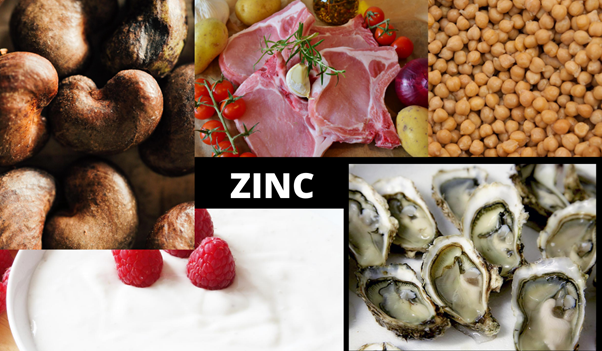
How much one should consume zinc included food?
According to the researchers, the recommended amount of zinc needed in your daily diet is 8 milligrams per day for women; 11 milligrams per day for men. Pregnant women should get 11 milligrams a day.
Vitamin E
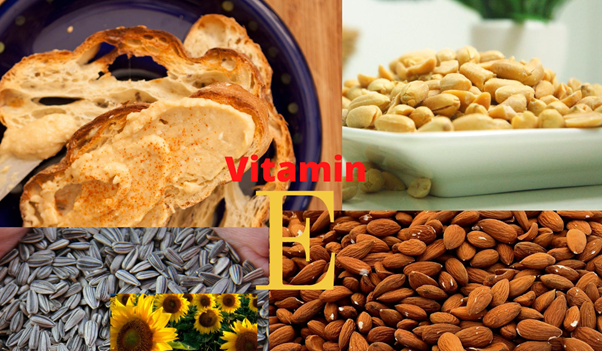
Vitamin E is another important supplement that is required to maintain eye health. The very reason to include it in this list is our body does not create Vitamin E. It helps in protecting cells in the eye from unstable molecules. Researchers suggested that mostly vitamin E is found in nuts, fortified cereals, and sweet potatoes, Almonds, broccoli, peanut butter, spinach, sunflower seeds, a wheat germ that can help protect the cell from damage.
Not only this, but Vitamin E also plays a significant role in improving the immune system of your body, it helps in repairing DNA and another metabolic process.
Food that makes the combination of Vitamin E and lutein and zeaxanthin helps to reduce the risk of cataract in the long run. Here is table which shows how much amount of Vitamin E certain food items have:
Key Takeaways
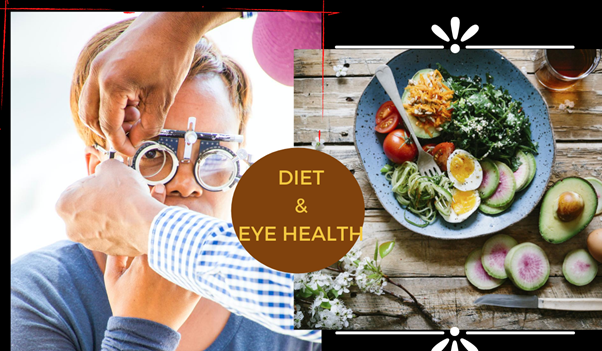
An abundance of evidence links that suggest eating more vegetables and fruits helps with better eye health as one age. Following the Dietary Guidelines as mentioned in the above article one should strictly abide with the quantity of supplement that they are taking for getting good results for the long run. For those already affected by AMD, health care providers may recommend supplementation.
Dietitian nutritionists should consider incorporating the topic of eye health into conversations with older patients and clients and should suggest them to consume ample amounts of vegetables and fruits.
Why it is so important to eat healthy for eye health?
Our body has cells that are constantly contained with the substance called free radicals. These free radicals have the power to damage almost anything and everything inside your eye like DNA, the inside of artery walls and even the proteins in the eye. Some of these free radical substance is developed in the body by taking the food and turning it into energy whereas others come from the air we breathe. It is not that we cannot do anything about these free radical that already exists in our body. Instead, we can help these free-radical fighters, named antioxidants, from the food we eat. This is the reason why we should eat the right vitamins, minerals, fatty acids etc.
Disclaimer for images: The images in the article are made by _________ and not sourced. We take full responsibility for the images.

